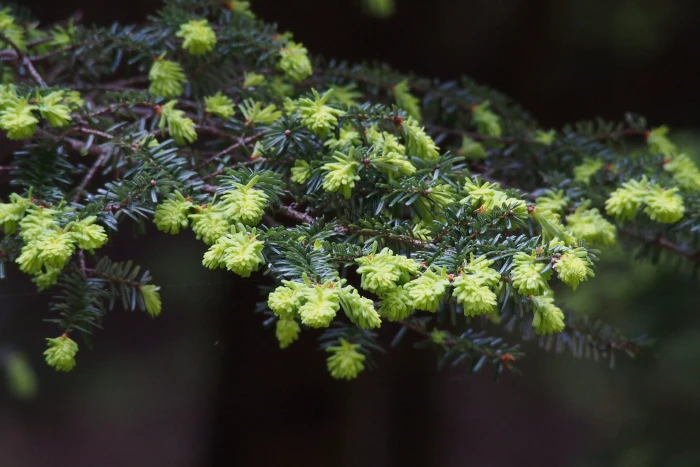Northern Japanese Hemlock
(Tsuga diversifolia)
Northern Japanese Hemlock (Tsuga diversifolia)
/
/

harum.koh
CC BY-SA 2.0
Image By:
harum.koh
Recorded By:
Copyright:
CC BY-SA 2.0
Copyright Notice:
Photo by: harum.koh | License Type: CC BY-SA 2.0 | License URL: https://creativecommons.org/licenses/by/2.0/ | Uploader: harum.koh | Publisher: Flickr |





























Estimated Native Range
Climate Requirements for Rosenberg, Texas
| This Plant | Your Site | Plant Suitability for Your Location | ||
|---|---|---|---|---|
| • Precipitation | 17" - 98" | 44" | Aquatic | Aquatic |
| • High Temp. | 64°F - 89°F | 94°F | Your summers may be too hot for this plant. | Too hot |
| • Low Temp. | 2°F - 33°F | 40°F | OK, but your winter temperatures are warmer than normal for this plant | OK |
This plant should grow well at your location with about N inches per year (Y minutes per month) of irrigation.
Summary
Tsuga diversifolia, commonly known as Northern Japanese Hemlock, is an evergreen tree native to the cool temperate forests of Japan, often found on moist, shaded mountain ridges. It can reach heights of up to 25 meters (80 feet) with a narrow, dense, and conical crown. The young shoots are short and palely pubescent, displaying a bright orange to red-brown color. The needles are linear-oblong, 5 to 15 mm long, and up to 2.4 mm wide, presenting a dark green, glossy, and furrowed appearance on the upper side with two distinct chalk white stomatal bands on the underside. The bark of Northern Japanese Hemlock is orange-brown, shallowly fissured, and peels vertically. Buds are deep purple-red, while the dull purple, ovoid pistillate flowers are terminal on shoots, maturing to pale green with purple accents. The cones are dark brown, pendulous, cylindric-ovoid, nearly sessile, and measure 1.8 to 2.8 cm long with slightly convex, ridged scales.
This species is valued for its graceful form and the textural contrast its foliage provides in shaded garden settings. It is suitable for use as a specimen tree, in woodland gardens, or as a part of mixed conifer collections. Northern Japanese Hemlock requires part shade to full shade, consistent medium moisture, and well-drained soils to thrive. It is relatively low-maintenance once established but can be susceptible to pests such as hemlock woolly adelgid, which can be a serious threat requiring management.CC BY-SA 4.0
This species is valued for its graceful form and the textural contrast its foliage provides in shaded garden settings. It is suitable for use as a specimen tree, in woodland gardens, or as a part of mixed conifer collections. Northern Japanese Hemlock requires part shade to full shade, consistent medium moisture, and well-drained soils to thrive. It is relatively low-maintenance once established but can be susceptible to pests such as hemlock woolly adelgid, which can be a serious threat requiring management.CC BY-SA 4.0
Plant Description
- Plant Type: Tree
- Height: 30-40 feet
- Width: 15-20 feet
- Growth Rate: Slow
- Flower Color: N/A
- Flowering Season: Non-Flowering
- Leaf Retention: Evergreen
Growth Requirements
- Sun: Part Shade, Full Shade
- Water: Medium
- Drainage: Medium
Common Uses
Bird Garden, Hedges, Low Maintenance, Rock Garden
Natural Habitat
Cool temperate forests of Japan, often found on moist, shaded mountain ridges
Other Names
Common Names: Japanese Subalpine Hemlock, Japanese Hemlock, North Japanese Hemlock, Kometsuga, Japanische Hemlocktanne, Nordjapanische Hemlocktanne, Tsuga Diversifolié, Észak-Japáni Hemlokfenyo, Tsuga Diversifoglia, Тсуга Разнообразнолистная (Tsuga Raznoobraznolistnaya)
Scientific Names: Tsuga diversifolia, Abies diversifolia, Abies tsuga var. nana, Pinus araragi var. diversifolia, Tsuga blaringhemii, Tsuga diversifolia subsp. blaringhemii
GBIF Accepted Name: Tsuga diversifolia (Maxim.) Mast.